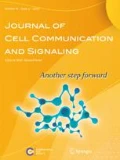Abstract
This commentary briefly summarizes the extraordinary resurgence of hormesis within the biological, biomedical, toxicological and risk assessment domains over the past two decades. It places this resurgence within the context of challenging the scientific validity of the threshold and linear dose responses. It argues that conducting research on mechanisms that actuate and regulate the stimulatory response features of hormesis will provide the knowledge needed to develop potentially transformational applications aimed at protecting and enhancing biological resiliency as well as treating/curing a multitude of diverse medical conditions.

References
Bernal AJ, Dolinoy DC, Huang D, Skaar DA, Weinhouse C, Jirtle RL (2013) Adaptive radiation-induced epigenetic alterations mitigated by antioxidants. FASEB J 27:665–671
Calabrese EJ (2008) Hormesis: why it is important to toxicology and toxicologists. Environ Toxicol Chem 27:1451–1474
Calabrese EJ (2015) On the origins of the linear no-threshold (LNT) dogma by means of untruths, artful dodges and blind faith. Environ Res 142:432–442
Calabrese EJ (2016a) Preconditioning is hormesis part I: documentation, dose-response features and mechanistic foundations. Pharmacol Res 110:242–264
Calabrese EJ (2016b) Preconditioning is hormesis part II: how the conditioning dose mediates protection: dose optimization within temporal and mechanistic frameworks. Pharmacol Res 110:265–275
Calabrese EJ (2017) Flaws in the LNT single-hit model for cancer risk: an historical assessment. Environ Res 158:773–788
Calabrese EJ (2018) From Muller to mechanism: how LNT became the default model for cancer risk assessment. Environ Pollut 241:289–302
Calabrese EJ, Agathokleous E (2018) Building biological shields via Hormeis. Trends Pharmacol Sci 40(1):8–10
Calabrese EJ, Baldwin LA (1997) A quantitatively-based methodology for the evaluation of chemical hormesis. Hum Ecol Risk Assess 3:545–554
Calabrese EJ, Baldwin LA (2001a) The frequency of U-shaped dose responses in the toxicological literature. Toxicol Sci 62:330–338
Calabrese EJ, Baldwin LA (2001b) Hormesis: U-shaped dose responses and their centrality in toxicology. Trends Pharmacol Sci 22:285–291
Calabrese EJ, Baldwin LA (2003a) Hormesis: the dose-response revolution. Annu Rev Pharmacol Toxicol 43:175–197
Calabrese EJ, Baldwin LA (2003b) The hormetic dose-response model is more common than the threshold model in toxicology. Toxicol Sci 71:246–250
Calabrese EJ, Blain RB (2011) The hormesis database: the occurrence of hormetic dose responses in the toxicological literature. Regul Toxicol Pharmacol 61:73–81
Calabrese EJ, Baldwin LA, Holland CD (1999) Hormesis: a highly generalizable and reproducible phenomenon with important implications for risk assessment. Risk Anal 19:261–281
Calabrese EJ, Staudenmayer JW, Stanek EJ, Hoffmann GR (2006) Hormesis outperforms threshold model in National Cancer Institute antitumor drug screening database. Toxicol Sci 94:368–378
Calabrese EJ, Agathokleous E, Kozumbo WJ, Stanek EJ 3rd, Leonard D (2019) Estimating the range of the maximum hormetic stimulatory response. Environ Res 170:337–343
Crocetti S, Beyer C, Schade G, Egli M, Frohlich J, Franco-Obrego A (2013) Low intensity and frequency pulsed electromagnetic fields selectively impair breast Cancer cell viability. PLoS One 8(9):e72944. https://doi.org/10.1371/journal.pone.0072944
Huang YY, Sharma SK, Carroll J, Hamblin MR (2011) Biphasic dose response in low level light therapy - an update. Dose-Response 9:602–618
Leak RK, Calabrese EJ, Kozumbo WJ, Gidday JM, Johnson TJ, Mitchell JR, Ozaki CK, Wetzker R, Bast A, Belz RG, Bøtker HE, Koch S, Mattson MP, Simon RP, Jirtle RL, Melvin E, Andersen ME (2018) Enhancing and extending biological performance and resilience. Dose-Response 16(3). https://doi.org/10.1177/1559325818784501
Nascarella MA, Stanek EJ III, Hoffmann GR, Calabrese EJ (2009) Quantification of hormesis in anticancer-agent dose responses. Dose-Response 7:160–171
Pilla A, Fitzsimmons R, Muehsam D, Wu J, Rohde C, Casper D (2011) Electromagnetic fields as first messenger in biological signaling: application to calmodulin-dependent signaling in tissue repair. Biochim Biophys Acta 1810:1236–1245
Salehpour F, Mahmoudi J, Kamari F, Sadigh-Eteghad S, Rasta SH, Hamblin MR (2018) Brain Photobiomodulation therapy: a narrative review. Mol Neurobiol 55:6601–6636
Sannino A, Zeni O, Romeo S, Massa R, Gialanella G, Grossi G, Manti L, Vijayalaxmi, Scarfi MR (2014) Adaptive response in human blood lymphocytes exposed to non-ionizing radiofrequency fields: resistance to ionizing radiation-induced damage. J Radiat Res 55:210–217
Sun C, Wei XX, Fei Y, Su LL, Zhao XY, Chen GD, Xu ZP (2016) Mobile phone signal exposure triggers a hormesis-like effect in Atm(+/+) and Atm(−/−) mouse embryonic fibroblasts. Sci Rep 6
Acknowledgements
EJC acknowledges longtime support from the US Air Force (AFOSR FA9550-13-1-0047) and ExxonMobil Foundation (S18200000000256). The views and conclusions contained herein are those of the author and should not be interpreted as necessarily representing policies or endorsement, either expressed or implied. Sponsors had no involvement in study design, collection, analysis, interpretation, writing and decision to and where to submit for publication consideration.
Author information
Authors and Affiliations
Corresponding author
Ethics declarations
Conflict of interests
None.
Additional information
Publisher’s note
Springer Nature remains neutral with regard to jurisdictional claims in published maps and institutional affiliations.
Rights and permissions
About this article
Cite this article
Kozumbo, W.J., Calabrese, E.J. Two decades (1998–2018) of research Progress on Hormesis: advancing biological understanding and enabling novel applications. J. Cell Commun. Signal. 13, 273–275 (2019). https://doi.org/10.1007/s12079-019-00517-7
Received:
Accepted:
Published:
Issue Date:
DOI: https://doi.org/10.1007/s12079-019-00517-7

